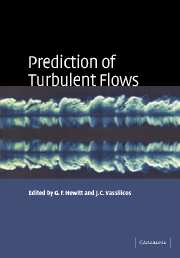Book contents
- Frontmatter
- Contents
- 1 Introduction
- 2 Developments in the understanding and modelling of turbulence
- 3 RANS modelling of turbulent flows affected by buoyancy or stratification
- 4 Turbulent flames
- 5 Boundary layers under strong distortion: an experimentalist's view
- 6 Turbulence simulation
- 7 Computational modelling of multi-phase flows
- 8 Guidelines and criteria for the use of turbulence models in complex flows
3 - RANS modelling of turbulent flows affected by buoyancy or stratification
Published online by Cambridge University Press: 12 August 2009
- Frontmatter
- Contents
- 1 Introduction
- 2 Developments in the understanding and modelling of turbulence
- 3 RANS modelling of turbulent flows affected by buoyancy or stratification
- 4 Turbulent flames
- 5 Boundary layers under strong distortion: an experimentalist's view
- 6 Turbulence simulation
- 7 Computational modelling of multi-phase flows
- 8 Guidelines and criteria for the use of turbulence models in complex flows
Summary
Introduction
The aim of this chapter is to provide, in plain English, a guide to the capabilities and shortcomings of turbulence models for reproducing satisfactorily engineering flows where buoyant or stratification effects are important. While these two descriptors are often used interchangeably in the literature, in the present chapter buoyant is used to denote a situation where the effect of gravity is to cause a force field whose primary effect is on the mean flow, while stratified implies that the principal effects on the flow arise from gravitational action on the turbulent fluctuating velocities. The distinction is neither pedantic nor unimportant; for, a stratified flow will ordinarily require a more rigorous modelling of gravitational effects than a buoyant flow. Put another way, gravitational effects on horizontal flows are more troublesome than on vertical flows. The account may hopefully also be useful where the flows of interest are affected by other types of force field, perhaps particularly flows affected by Coriolis forces or swirl.
The chapter gives especial attention to two-equation models of turbulence as this is currently the main level of commercial CFD. Linear two-equation eddyviscosity models are considered first, beginning with the situation where buoyant/stratification effects are absent. This is important to enable the reader to assess whether, for the flows of interest, a linear eddy viscosity model would be suitable even in a uniform density situation. Thereafter, the treatment of buoyant flows with linear two-equation models is considered.
Information
- Type
- Chapter
- Information
- Prediction of Turbulent Flows , pp. 50 - 127Publisher: Cambridge University PressPrint publication year: 2005
